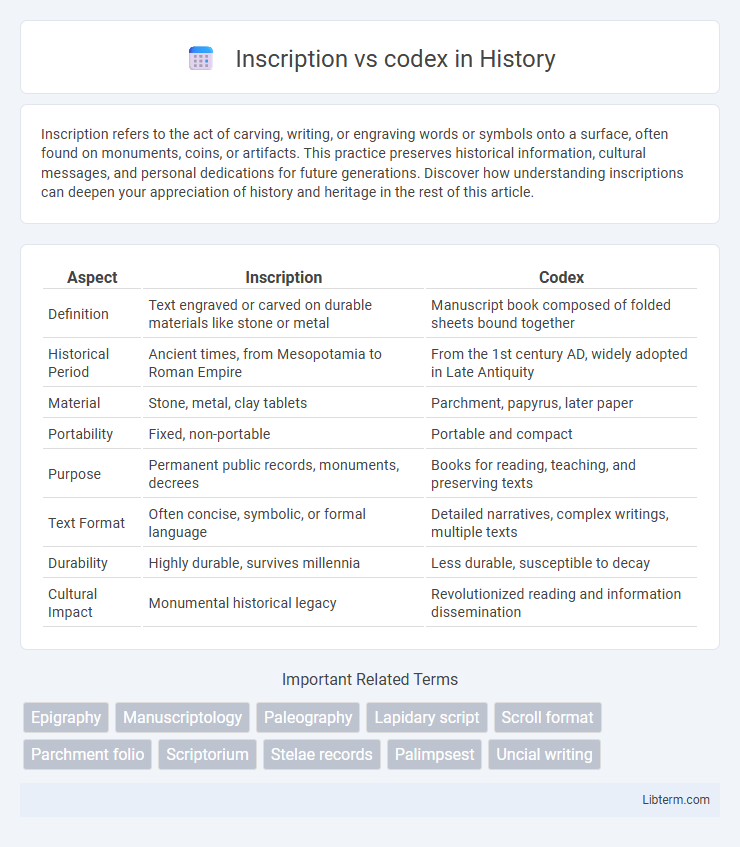Inscription refers to the act of carving, writing, or engraving words or symbols onto a surface, often found on monuments, coins, or artifacts. This practice preserves historical information, cultural messages, and personal dedications for future generations. Discover how understanding inscriptions can deepen your appreciation of history and heritage in the rest of this article.
Table of Comparison
| Aspect | Inscription | Codex |
|---|---|---|
| Definition | Text engraved or carved on durable materials like stone or metal | Manuscript book composed of folded sheets bound together |
| Historical Period | Ancient times, from Mesopotamia to Roman Empire | From the 1st century AD, widely adopted in Late Antiquity |
| Material | Stone, metal, clay tablets | Parchment, papyrus, later paper |
| Portability | Fixed, non-portable | Portable and compact |
| Purpose | Permanent public records, monuments, decrees | Books for reading, teaching, and preserving texts |
| Text Format | Often concise, symbolic, or formal language | Detailed narratives, complex writings, multiple texts |
| Durability | Highly durable, survives millennia | Less durable, susceptible to decay |
| Cultural Impact | Monumental historical legacy | Revolutionized reading and information dissemination |
Introduction: Understanding Inscriptions and Codices
Inscriptions are permanent texts engraved or carved on durable materials like stone, metal, or clay, serving as historical records or monumental messages. Codices represent ancient manuscript books made from materials such as parchment or bark, organized into pages for easier reading and preservation. Both forms provide critical insights into the cultural, religious, and administrative practices of past civilizations.
Historical Origins of Inscriptions
Inscriptions trace their origins to ancient civilizations such as Mesopotamia, Egypt, and the Indus Valley, where early societies used carved or engraved texts on stone, metal, or clay to record laws, religious decrees, and historical events. These permanent records provided durable, public documentation, differentiating inscriptions from the later codex format, which emerged during the Roman Empire as a bound manuscript for more flexible and portable writing. The historical significance of inscriptions lies in their role as some of the earliest forms of durable written communication, preserving information across millennia.
The Emergence of the Codex Format
The emergence of the codex format marked a significant transition from traditional inscription methods, allowing for more efficient storage and accessibility of written texts on parchment or vellum. Unlike inscriptions carved into stone or metal, codices provided a portable, durable, and expandable medium that facilitated the compilation of multiple texts within a single volume. This innovation spurred the spread of literacy and knowledge preservation throughout the Roman Empire and early Christian communities.
Material Differences: Stone vs Parchment
Inscriptions are typically carved into durable materials such as stone, providing longevity and resistance to environmental degradation. Codices are constructed from parchment, a flexible and lightweight material made from animal skins, allowing for portability and ease of writing. The physical properties of stone make inscriptions permanent monuments, whereas parchment in codices facilitates extensive textual compilation and frequent handling.
Evolution of Writing Technologies
Inscription represents the earliest form of writing technology, involving engraving or carving symbols onto durable materials like stone, clay, or metal to ensure long-term preservation of information. The codex, emerging around the 1st century AD, revolutionized writing by introducing bound pages made of papyrus or parchment, enhancing portability and accessibility compared to cumbersome inscriptions. This evolution from inscription to codex marked a significant technological shift, enabling more efficient storage, dissemination, and interaction with written texts across cultures.
Accessibility and Distribution
Inscriptions, typically carved into stone or metal, have limited accessibility due to their fixed locations and physical durability, making them difficult to disseminate widely. Codices, as portable manuscripts bound in book form, revolutionized accessibility by enabling easier handling, copying, and transportation, significantly enhancing distribution across regions. The codex format allowed for mass reproduction and broader reach, facilitating the spread of knowledge beyond localized inscriptions.
Preservation and Longevity
Inscriptions, typically etched onto durable materials like stone or metal, offer exceptional preservation and longevity, often surviving for millennia with minimal degradation. Codices, made from organic materials such as parchment or paper, are more susceptible to environmental factors like moisture, pests, and physical wear, which can significantly reduce their lifespan without careful conservation. Advanced preservation techniques, including controlled climate storage and digital archiving, are essential to extend the longevity of codices, whereas inscriptions naturally endure the passage of time with less intervention.
Cultural and Religious Significance
Inscriptions, often carved on stone or metal, served as durable records for religious decrees, monumental dedications, and ritualistic texts, symbolizing divine authority and cultural permanence in ancient civilizations. Codices, composed of bound parchment or paper, became vital in preserving sacred scriptures, liturgical instructions, and theological knowledge within religious communities, facilitating transmission and interpretation across generations. Both mediums reflect profound cultural significance, with inscriptions embodying public and ritualistic memory, while codices allowed for personalized study and continuity of religious traditions.
Impact on Knowledge Transmission
Inscriptions, typically etched on stone or metal, served as durable records that preserved legal, religious, and cultural information across generations, ensuring long-term stability of knowledge. Codices, made from materials like parchment or paper, allowed for easier editing, compilation, and dissemination of complex texts, significantly enhancing the accessibility and spread of knowledge in ancient and medieval societies. The transition from inscriptions to codices marked a pivotal shift, accelerating intellectual exchange and facilitating the development of literature, science, and administrative systems.
Modern Perspectives on Inscriptions and Codices
Modern perspectives on inscriptions emphasize their role as durable records etched in stone or metal, offering critical insights into ancient civilizations, legal systems, and rituals. Codices, typically composed of pages bound together, are valued for their versatility in preserving extensive textual content, such as religious manuscripts and historical chronicles. Contemporary scholarship leverages digital imaging and AI to analyze both inscriptions and codices, enhancing the understanding of linguistic evolution and cultural contexts.
Inscription Infographic

 libterm.com
libterm.com